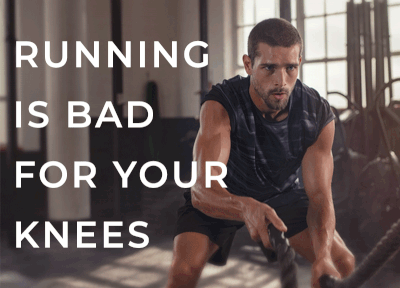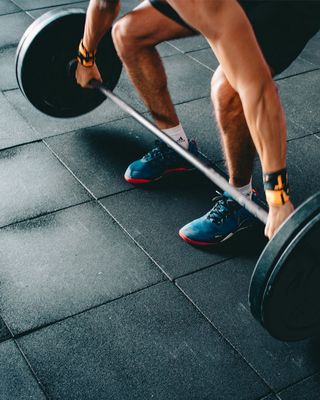
11 Fitness Myths You Need To Forget
MYTH 1: Soreness Is Essential For Muscle Growth
Delayed onset muscle soreness (DOMS) isn’t required for muscle growth, and science shows no correlation between the degree of exercise-induced muscle soreness and the effectiveness or quality of a workout. Contrary to old-school thinking, DOMS isn’t caused by the build-up of lactic acid in muscles – the body doesn’t even produce lactic acid. Science is still trying to nail down the exact mechanisms behind DOMS, but we do know it is likely caused by the body’s response to muscle damage, which is a natural consequence of vigorous exercise – and a key stimulus for muscle growth. Typically, DOMS will be more severe in untrained individuals just starting a training programme, those returning after a period of no training, and veterans switching up their routines with new training methods.
MYTH 2: You’re Born A Sprinter Or An Endurance Athlete
Most people are born with fairly equal amounts of type 1 (slow twitch) and type 2 (fast twitch) muscle fibres, but there is always going to be variation among individuals. Those with a higher proportion of type 1 fibres are likely to perform better in endurance sports; those with more type 2 fibres are more apt to excel in power or strength. But no matter your ratio of type 1 to type 2 fibres, every muscle in your body has both, so you can make progress toward any fitness goal. For example, if you’re someone with a greater number of type 2 fibres, you can still train for a marathon. In short, you don’t have to let your genetics determine your exercise preferences. Your body will adapt to whatever form of exercise you choose.
MYTH 3: You Need To Plank To Get A Six-Pack
To sculpt chiselled, washboard abs, you need to work your entire core with a variety of exercises, preferably ones that encourage you to keep your spine neutral. Hanging leg (or knee) raises are perfect for this. Start by hanging from a bar. Engage your core muscles to keep the spine neutral (think about pulling the front of your pelvis up and drawing your tailbone under, while bracing your tummy, as though you’re about to get punched). Then slowly raise and lower your legs without letting your pelvis or spine change position. However, research also shows it’s tough to beat the plank when it comes to engaging (and strengthening) your core musculature, including your abs.
MYTH 4: Running Is Bad For Your Knees
Running generally poses no greater risk for your knees than any other physical activity as long as you perform it with good technique and balanced training. Research shows that if you land heel-first when running, you’re more prone to knee injuries than people who typically touch down with their mid to forefoot. However, studies also show changing your foot strike pattern doesn’t reduce your risk of running-related injuries. Focus instead on wearing comfortable shoes and improving other aspects of your running form: keep your head neutral; swing your arms forwards and backwards, not across your body, with elbows bent at 90º; and maintain a slight forward lean from your ankles, not your waist. Also, make sure strength training is part of your plan, as research shows it can reduce sports injuries by a third and cut overuse injuries in half.
MYTH 5: HIIT Is The Best Way To Lose Weight
Until very recently, research seemed to suggest HIIT was the most effective form of exercise for shedding fat thanks to its high energy cost. The latest studies show most forms of exercise are fairly equal when it comes weight loss. Exercise is important for increasing your overall fitness level and achieving specific goals, and it does contribute to fat loss by increasing your calorie burn, but dialling in your diet and increasing your overall daily activity level are more important. You may have heard that you can’t ‘out-exercise’ a bad diet, and it’s true. When it comes to losing weight, you have to start with your eating habits.

MYTH 6: The More Protein, The Better
As with most things in life, there can be too much of a good thing. Eat too much protein, particularly animal protein, and there may be a price to pay. A diet containing lots of animal-derived protein such as meat and dairy can contain higher amounts of saturated fat, which can raise the risk of heart disease and colon cancer. Such diets are also high in uric acid, which can increase the risk of kidney stones. A diet rich in plant-based proteins may not carry similar risks, and the fibre in plant foods can slow digestion, reduce LDL cholesterol and maintain gut health. A sensible guide for protein is around 2g per kg of bodyweight per day.
MYTH 7: You Need Supplements To See Gains
You can reach your goals without taking supplements, but including them in your training can help you perform better and achieve the results you want faster. The key is to select the supplements that best support your goals. If your primary focus is muscle growth, taking creatine consistently and consuming a protein shake daily can put you on the fast track to a stronger, more defined physique.
MYTH 8: The More You Lift, The Stronger You’ll Get
Focusing on heavy lifting (i.e. training primarily in the 2-6 rep range) is best for building strength, but to maximise muscle size, you should predominantly use weights that challenge you to complete 8-12 reps per set with good form. Research shows that’s the sweet spot for the hypertrophy (i.e. growth) of type 2 muscle fibres, which are the largest and strongest, and have the greatest growth potential. But studies also show type 1 (endurance-oriented) muscle fibres can increase in size with proper training. Admittedly, their growth potential isn’t as great as the more powerful type 2 fibres, but by including low weight/high rep sets (15+) in your training plan, you’ll target those type 1 fibres and optimise muscle growth.
MYTH 9: You Should Work Out On An Empty Stomach
This depends on your goals. When trying to achieve a personal best or sustain a long workout, your body needs fuel in the form of glucose. While your muscles and liver can store some (in the form of glycogen), the rest must come from your bloodstream. If there’s none available, your body must break down fat into glucose, which is a slower process, and thus might impede your performance. Remember, you’ll achieve your fitness goals faster if you enjoy your workouts and stay consistent. If working out on an empty stomach makes it less enjoyable and unsustainable for you, don’t do it.
MYTH 10: You Should Always Stretch Before A Workout
Yes, but what’s crucial is knowing how to stretch properly. Static stretching is an ineffective way to warm up, as it sends an inhibitory signal to your muscles. In other words, it hits your muscular ‘off switch’ instead of exciting your neuromuscular system and priming your body for action. Warm-ups should consist of controlled, dynamic movements that mimic the movement patterns of the workout you intend to do, gradually increasing in range of motion, speed and intensity. That could mean starting your run with a brisk walk, or starting a lower-body workout with bodyweight squats and high knees before transitioning to loaded exercises that involve dumbbells, barbells and other resistance tools.
MYTH 11: Machines Are Better Than Free Weights
This isn’t true. Free weights are superior to exercise machines, which can lock you into unnatural movement patterns and do some of the work for you. That can be beneficial if you’re recovering from an injury, but if you’re healthy, stick to barbells, dumbbells and other resistance tools that don’t provide any assistance. In addition to helping you build more functional, real-world strength, free weights can help you improve your fine motor skills and more effectively work the smaller stabilising muscles throughout your body. Plus, using them requires greater core engagement, which is critical for increasing total body strength and power.
For more information, visit OpenFit.com
DISCLAIMER: We endeavour to always credit the correct original source of every image we use. If you think a credit may be incorrect, please contact us at [email protected].